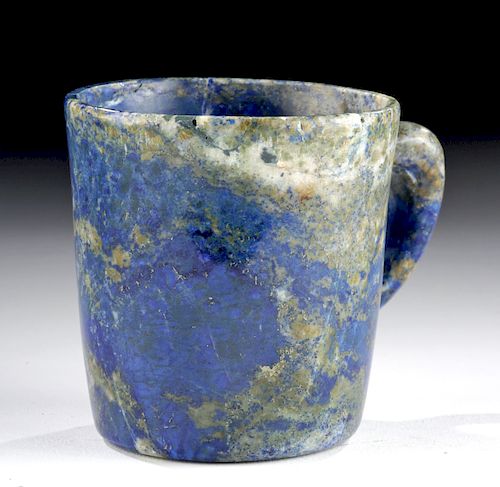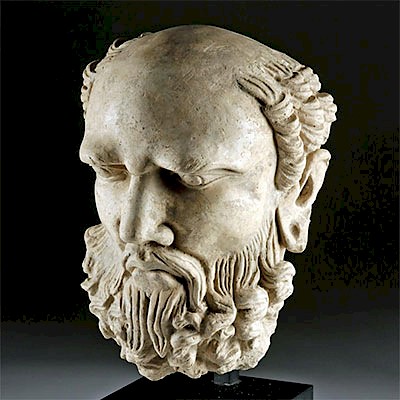Gorgeous Bactrian Carved Lapis Lazuli Handled Cup
Lot 123
About Seller
Artemis Fine Arts
686 S Taylor Ave, Ste 106
Louisville, CO 80027
United States
Selling antiquities, ancient and ethnographic art online since 1993, Artemis Gallery specializes in Classical Antiquities (Egyptian, Greek, Roman, Near Eastern), Asian, Pre-Columbian, African / Tribal / Oceanographic art. Our extensive inventory includes pottery, stone, metal, wood, glass and textil...Read more
Categories
Estimate:
$2,800 - $4,200
Absentee vs Live bid
Two ways to bid:
- Leave a max absentee bid and the platform will bid on your behalf up to your maximum bid during the live auction.
- Bid live during the auction and your bids will be submitted real-time to the auctioneer.
Bid Increments
| Price | Bid Increment |
|---|---|
| $0 | $25 |
| $300 | $50 |
| $1,000 | $100 |
| $2,000 | $250 |
| $5,000 | $500 |
| $10,000 | $1,000 |
| $20,000 | $2,500 |
| $50,000 | $5,000 |
| $100,000 | $10,000 |
| $200,000 | $20,000 |
About Auction
By Artemis Fine Arts
Jan 16, 2020
Set Reminder
2020-01-16 10:00:00
2020-01-16 10:00:00
America/New_York
Bidsquare
Bidsquare : Ancient | Asian | Ethnographic
https://www.bidsquare.com/auctions/artemis-gallery/ancient-asian-ethnographic-4799
Featuring classical antiquities, ancient and ethnographic art from cultures encompassing the globe. Artemis Fine Arts info@artemisfinearts.com
Featuring classical antiquities, ancient and ethnographic art from cultures encompassing the globe. Artemis Fine Arts info@artemisfinearts.com
- Lot Description
Ancient Central Asia, Bactria, ca. 1000 BCE. A finely-carved lapis lazuli cup with a cylindrical body and single looped handle, most impressive for its saturated royal blue hues. In addition to being used to create beautiful jewelry, lapis lazuli was also used by the ancients to carve more practical objects such as game boards, stamps, hair combs, dagger handles, bowls, and cups like this example. During ancient times, merchants delivered lapis from the mines of Bactria via caravan and trade routes to cities in Greece, Egypt, India, Mesopotamia, China, Japan, and Persia . In 1271, Marco Polo wrote about the lapis mines in Bactria; however, not too many knew about them because of the treacherous terrain. Size: 2.5" in diameter x 2.625" H (6.4 cm x 6.7 cm); 3.375" W (8.6 cm) from handle
The ancient mines of Bactria were a valuable source of lapis lazuli of the best color. Lapis was used to carve statuettes of birds and animals as well as dishes, cylinder seals, and beads that have been found in the royal Sumerian tombs of Ur - and jewelry made from lapis was found in Egyptian burial sites dating prior to 3000 BCE. Egyptian women used powdered lapis as eye shadow, and Pliny the Elder waxed poetic about the stone, describing it as "a fragment of the starry firmament."
Provenance: private California, USA collection, purchased near the Iran/Afghanistan border in the 1960s and brought to the US in 1966-1969
All items legal to buy/sell under U.S. Statute covering cultural patrimony Code 2600, CHAPTER 14, and are guaranteed to be as described or your money back.
A Certificate of Authenticity will accompany all winning bids.
We ship worldwide and handle all shipping in-house for your convenience.
#149142Hemispheric section (rim to mid body) reattached with stable radiating fissures. Minute old nicks to rim. Nick by one side of handle may date to when the cup was carved. Otherwise generally excellent and so finely carved with a remarkably smooth finish inside and out.Condition
- Shipping Info
-
All shipping is handled in-house for your convenience. Your invoice from Artemis Gallery will include shipping calculation instructions. If in doubt, please inquire BEFORE bidding for estimated shipping costs for individual items.
-
- Buyer's Premium



 EUR
EUR CAD
CAD AUD
AUD GBP
GBP MXN
MXN HKD
HKD CNY
CNY MYR
MYR SEK
SEK SGD
SGD CHF
CHF THB
THB
















